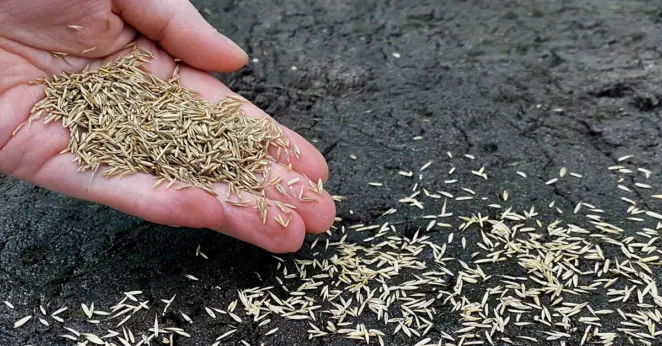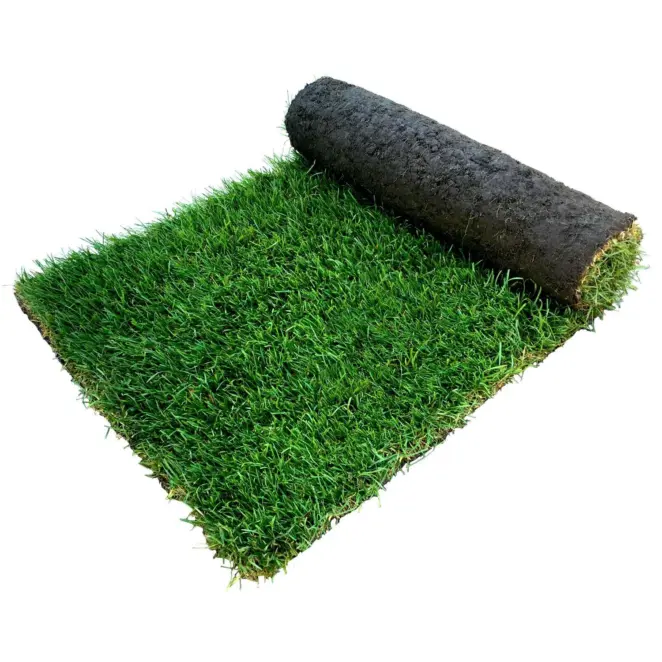Sowing Grass Seed
Grass seed can be used to create a brand-new lawn from scratch or to fill in bare patches of a pre-existing lawn. Sowing seed is easy and can be done by both professional and novice gardeners.
For the best results, grass seed should be sown either in the springtime (March-May) or in early autumn (September-November) as the mild climate is ideal for speedy seed germination. In ideal climates, you can expect to see results in 7-21 days.
The way that you sow seed will vary based on your lawn’s needs. If you’re looking to fill in patches / repair a damaged lawn, then you should overseed your lawn. If you’re wanting a brand-new lawn from scratch then you can sow an entire lawn with seed, though this does require patience and optimal climate.
Sowing A New Lawn
Preparing your area is key when it comes to laying a new lawn from seed. If your ground isn't prepared correctly then you likely won’t get the best results. You should remove any weeds, stones and general debris from your soil and then rake it so it is level. If your soil is poor quality, significantly waterlogged or has a clay-like consistency, you may want to invest in some high-quality topsoil and mix in with your pre-existing soil to create a new, high quality mix. You can check out our preparing your ground guide for more information.

- Calculate the required amount of seed by measuring the area. We recommend 25-35 g/m2 for sowing new lawns.
- Sow the seed evenly throughout the area, ensuring ample coverage throughout.
- Once sown, lightly rake the area to ensure the seed is covered with soil to allow it to germinate.
- Water after sowing and maintain a regular watering schedule- in warmer conditions, you should water 1-2 times daily minimum.
Overseeding a Lawn
If you’re looking to cover up patchy or thinner areas of your lawn, you can overseed to encourage re-growth. You should mow your lawn quite short before overseeding, being careful not to scalp the lawn. Aim to mow to a height of 1.5-2 inches, enough to expose the soil so that the seed can make contact with the ground. You can also aerate your lawn with a garden fork to encourage drainage and allow the seed to develop strong, stable root systems.
- Calculate the required amount of seed. For overseeding, we recommend 20g/m2.
- Spread the seed evenly over the affected area. Sowing in both directions can ensure an even, full coverage.
- Once sown, lightly rake / sprinkle topsoil over the area to ensure the seed is covered with soil to allow it to germinate.
- Water after sowing and maintain a regular watering schedule. In warmer conditions, you should water 1-2 times daily minimum.

Aftercare
Ensuring you’re looking after your newly seeded lawn is crucial for successful germination of the seeds.
Can I Walk on My Lawn After Sowing Seed?
You should limit foot traffic on the lawn for the first 2-3 weeks to minimise damage to the seeds as they begin to root in. Walking on the area can compact the soil which could limit the flow of water and nutrients to the area and possibly displace the seeds. This can affect the speed of their germination and overall health.
How Long Does Grass Seed Take to Grow?
Seed germination times vary depending on your local climate, ground quality and watering schedule.
In optimal conditions like warm temperatures and thorough watering, seed can germinate in as little as 1-2 weeks, with another 6-8 weeks before the grass has fully established.
In colder climates, it may take around 2-3 weeks for the seeds to germinate, with a slow grass growth to follow. In frosty conditions the grass will go dormant and may not begin growing again until temperatures increase.

When Can I Mow After Sowing Grass Seed?
Once your grass has grown to a height of around 3 inches, you should set your your mower blade to be significantly high and only take off around 1 inch in length.
You should also avoid mowing too frequently / short whilst the grass is still rooting in, as it could scalp and damage the lawn.
How Can I Stop Birds Eating the Grass Seed?
Pests such as birds will be attracted to the seed and will likely eat them if given the chance. To prevent this, you may want to sow more seed than originally needed to make sure the lawn is still covered if any seeds get picked off by birds. You can also apply a net to the freshly sown area.
If using a net, make sure you’re not limiting any sunlight or airflow to the seeded area. You can also use various pest deterrents, such as bird tape or feeders in other areas to lure the birds away from the newly sown seed.

The main component of Online Turf’s Rye Gold seed is Rye Grass, which makes it extra durable and hard-wearing.
The smooth stalked meadow grass, in addition to rye grass, offers protection and increased durability against general wear and tear all whilst producing a lush, bright green lawn.
The mix is highly adaptable and versatile, allowing it to blend into all different types of pre-existing lawn with ease.
Our Rye Gold turf is our most popular product and is the top choice for landscapers, homeowners and customers alike. Its quick growth, resilience and ornamental look gives you a thriving lawn that’s enjoyable all year-round.


